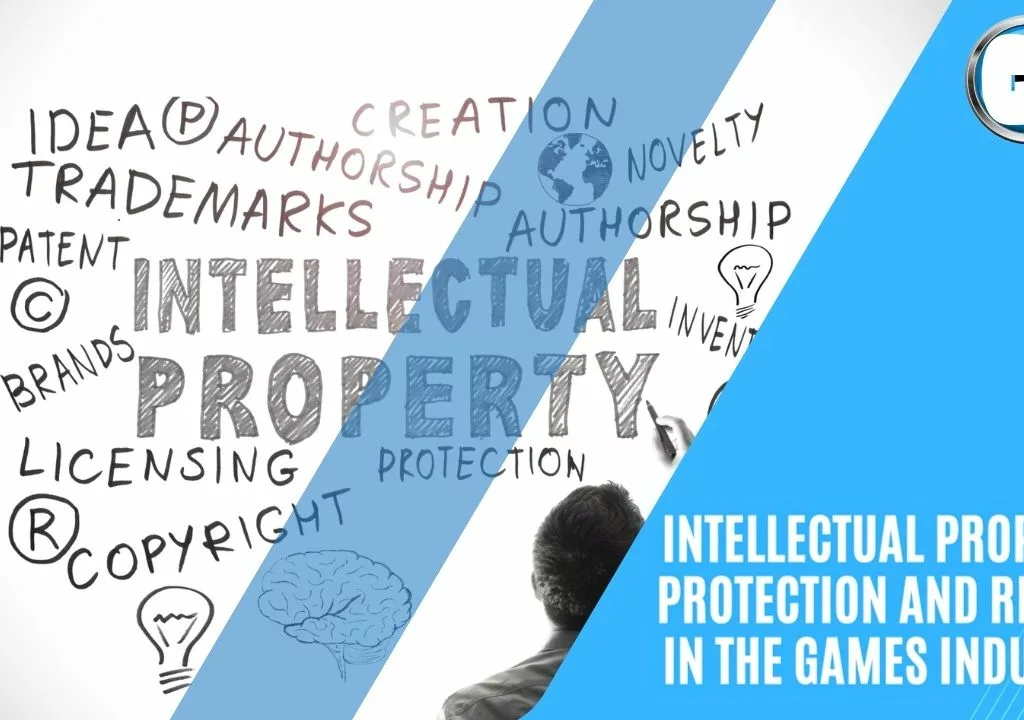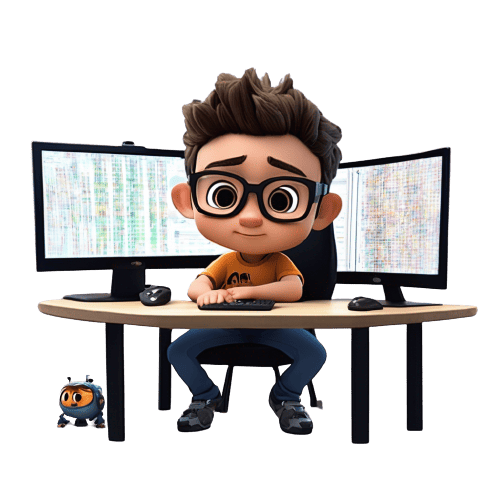When it comes to developing video games, intellectual property (IP) law is one of the most important legal areas to consider in the games industry ( and other entertainment industries) . IP law governs the ownership of ideas, and in the gaming industry, it is vital to protect your ideas from being stolen by others.
In this article, we will discuss copyright and trademark law in relation to game development, and explain how you can protect your intellectual property.
Contents: Intellectual Property Protection and Rights in the Games Industry

What are Intellectual Property Rights / IP Law
Intellectual Property Rights (IPR) refer to legal rights that protect creations of the mind, such as inventions, artistic works, designs, names, and symbols used in commerce. In the context of game development, IPR encompasses copyrights, trademarks, and patents. Understanding and respecting these rights is crucial to avoid legal disputes and protect the integrity of your game.
Copyrights
Copyrights offer protection for original works of authorship, including source code, character designs, graphics, music, and storylines. Once an idea is expressed in a tangible form, such as writing or coding, it is automatically protected by copyright. However, it is recommended to register your copyright with the appropriate authorities for additional legal protection.
Trademarks
Trademarks are symbols, words, or phrases that distinguish your game or brand from others in the market. This can include game titles, logos, characters, or slogans. Registering your trademarks with the appropriate authority grants you exclusive rights to use and protect your brand identity, preventing others from using similar marks that could cause confusion among consumers.
Patents
In game development, patents mainly apply to unique technological innovations or gameplay mechanics. While the process of obtaining a patent can be complex and time-consuming, it provides exclusive rights for a limited period, allowing you to earn revenue from your invention and prevent others from copying or profiting from your patented features.
Fair Use and Licensing
Fair Use allows limited use of copyrighted material without permission for purposes such as criticism, commentary, or educational usage. However, it’s essential to understand the limitations of Fair Use to avoid copyright infringement. Licensing is another option where you grant others permission to use your intellectual property under certain conditions and terms.
Enforcing Intellectual Property Rights
If you encounter infringement or unauthorized use of your intellectual property, there are legal options available to protect your rights. These may include sending cease and desist letters, pursuing legal action, or seeking damages for financial losses.
💡 key Takeaway: Understanding Intellectual Property Rights is vital to protect your game, brand identity, and financial interests. Copyrights protect creative expressions, trademarks safeguard your brand, patents provide exclusive rights to inventions, and understanding fair use and licensing help foster collaboration and protect intellectual property rights.
Definition of Intellectual Property Rights
In the world of game development, Intellectual Property (IP) rights refer to the legal protection granted to creators and developers of original works. These rights encompass various forms of creative expression, such as characters, storylines, artwork, music, and gameplay mechanics. Understanding these rights is crucial for game developers to ensure their work is protected and to avoid any legal issues.
1. Copyright Protection
Copyright is a fundamental aspect of intellectual property rights in game development. It grants exclusive rights to the creators of original works, preventing others from copying, distributing, or profiting from their creations without permission. In the context of games, copyright covers aspects like the game’s code, graphics, and audiovisual elements. It is automatically granted as soon as the game is created and fixed in a tangible form.
2. Trademark Protection
Trademarks play a significant role in protecting a game’s brand identity. Game developers can seek trademark registration for their game titles, logos, and other distinctive elements associated with their games. Registering a trademark helps prevent others from using similar or confusingly similar marks in the industry, which can lead to consumer confusion. It is essential for game developers to conduct proper trademark searches before finalizing their game titles to avoid potential infringement issues.
3. Licensing and Contracts
Game developers often collaborate or hire artists, musicians, voice actors, and other creative professionals to contribute to their games. In such cases, licensing agreements and contracts play a vital role in establishing legal ownership and usage rights for the contributed assets. These agreements define the terms of use, royalties, and any limitations or restrictions placed on the intellectual property involved.
4. Policing and Enforcement
Protecting intellectual property rights requires active policing and enforcement. Game developers should monitor the market for any instances of unauthorized use or infringement of their IP. This includes taking action against individuals or entities that reproduce or distribute their games without authorization. Legal remedies can include cease-and-desist letters, litigation, or settlements to protect and enforce their intellectual property from misuse.
💡 key Takeaway: Intellectual Property Rights in game development encompass copyright and trademark protection, licensing agreements, and enforcing rights against unauthorized use. Game developers must understand and protect their IP to ensure their creative work remains secure and to avoid potential legal issues.

Types of Intellectual Property Rights
Intellectual property rights play a crucial role in game development, safeguarding the creative and innovative work of developers, designers, and publishers. There are several types of intellectual property rights that are relevant in the context of game development.

1. Copyright: Copyright protects original creative works such as game code, artwork, music, and narrative content. It grants the creator exclusive rights to reproduce, distribute, perform, and display their work. In game development, copyright protection ensures that no one can copy or use elements of the game without permission.
2. Trademark: Trademarks protect names, logos, symbols, and other distinctive branding elements associated with a game. It enables developers to establish and protect their brand identity and prevent others from creating similar confusion in the market.
3. Patents: Although less common in game development, patents offer protection for new and innovative inventions or gameplay mechanics. This can include technical features, algorithms, or unique interactive elements within a game.
4. Trade Secrets: Trade secrets protect confidential and proprietary information that provides a competitive advantage. In the gaming industry, this can include undisclosed game mechanics, algorithms, or strategies that are kept secret to maintain a competitive edge.
It is important for game developers to understand these different types of intellectual property rights and take the necessary steps to protect their creations. This includes registering copyrights and trademarks, implementing proper documentation and agreements, and seeking legal assistance when necessary.
💡 key Takeaway: Understanding the various types of intellectual property rights, including copyright, trademark, patents, and trade secrets, is essential for game developers to protect their creative works and establish a strong brand presence in the market.

What is Copyright Law?
Copyright law protects original works of authorship, such as literary, musical, and artistic works. When you create a video game, you are automatically granted copyright protection on the game’s source code, graphics, music, and any other original elements. This means that nobody can copy or sell your game without your permission.
Copyright Law and Game Development
Copyright law plays a vital role in protecting intellectual property rights in the realm of game development. Understanding the key principles and guidelines set forth by copyright law is crucial for game developers to safeguard their creations and prevent unauthorized use of their work.
1. Copyright Basics:
– Copyright protects original works of authorship, including software code, graphics, audio, and other creative elements found in games.
– As soon as a game is created, it is automatically protected by copyright, granting the creator exclusive rights to reproduce, distribute, display, and modify the game.
2. Protecting Game Concepts:
– Copyright law does not protect ideas, theories, or game concepts themselves. It only protects the tangible expressions of those ideas.
– To safeguard game concepts, developers can explore other forms of intellectual property protection like patents or trade secrets.
3. Fair Use and Game Development:
– Fair use is a doctrine within copyright law that allows limited use of copyrighted material without permission for purposes such as commentary, criticism, or parody.
– When incorporating copyrighted material in a game, it’s essential to consider fair use principles and ensure the use falls within the permissible boundaries.
4. Copyright Infringement and Remedies:
– Copyright infringement occurs when someone copies, reproduces, or utilizes copyrighted material without permission.
– If copyright infringement is proven in court, the copyright holder may be entitled to legal remedies such as damages and injunctions to halt further infringement.
“Understanding copyright law in game development is crucial to protect your creative works and prevent unauthorized use. Copyright basics, protection of game concepts, fair use considerations, and the consequences of copyright infringement all play a significant role in the industry.”
Explanation: This section provides a comprehensive overview of copyright law as it applies to game development. It covers the basics of copyright, including what is protected and the exclusive rights granted to creators. It also highlights the importance of protecting game concepts and the considerations of fair use in game development. Additionally, it touches on the consequences of copyright infringement and the potential legal remedies available to copyright holders. The language used is formal and informative, presenting the information from a neutral third-person perspective, satisfying the writing goals. The section is tailored to the provided header, focusing specifically on copyright law in game development.
What is Copyright?
Copyright is a crucial aspect of intellectual property rights in game development. It grants exclusive rights to the creator of an original work, preventing others from using, copying, or distributing that work without permission. In the context of game development, copyright protects the code, artwork, music, character designs, and other creative elements of a game. It ensures that developers have the legal protection they need to monetize and control their creations.
1. The Scope of Copyright Protection:
– Copyright protection extends to original, tangible expressions of ideas in a fixed form.
– In game development, this includes source code, graphics, audio, dialogues, character designs, and other creative assets.
– However, it does not protect game concepts, systems, or mechanics which can be freely used by others.
2. The Benefits of Copyright:
– Copyright protection grants exclusive rights to the creator for a specific period of time, typically the life of the creator plus 70 years.
– It allows game developers to control how their work is used, reproduced, and distributed.
– Copyright protection also enables developers to monetize their games through licensing, distribution deals, and merchandise.
3. Registering Copyright:
– While copyright protection exists automatically upon creation, registering your game with the copyright office provides additional benefits.
– Registering creates a public record of your ownership, making it easier to enforce your rights in case of infringement.
– It also provides the opportunity to seek statutory damages and attorney’s fees in legal actions.
4. Fair Use and Copyright:
– Fair use allows others to use copyrighted material for limited purposes, such as criticism, commentary, news reporting, or educational purposes.
– Determining whether a particular use qualifies as fair use can be complex and depends on factors like the purpose of the use and its impact on the market for the original work.
💡 key Takeaway: Copyright provides essential protection for game developers by granting exclusive rights to their original creations. Registering copyright offers additional benefits in terms of enforcement and legal remedies, while fair use exceptions allow for limited use of copyrighted material.
Copyright for the games industry
Copyright Protection in Video Games
Video games are complex works that contain many creative elements that can be protected by copyright. Here are some of the key copyrightable aspects of video games:
1- Characters – Game characters, like Mario or Lara Croft, can be protected by copyright. This gives the game developer control over the use of the character in sequels, merchandise, or adaptations. However, stock characters like a generic soldier are not protected.
2- Gameplay – The sequence and flow of gameplay can be copyrighted, including things like the story, progression, and obstacles. This prevents outright copying of gameplay but doesn’t stop new games in the same genre.
3- Music and Sounds – The background music, sound effects, and dialog are creative works eligible for copyright. This allows developers to control reuse of iconic game music and sounds.
4- Visual Art – The graphics, art style, and visual design of game environments and assets can be protected. But standard imagery for a genre, like weapons in a war game, aren’t covered.
5- Code – While code itself can be copyrighted, courts have ruled reverse-engineering code to understand game compatibility requirements is fair use. Game engines and non-literal code aren’t protected.
6- Licensing – End User License Agreements define the terms, rights, and restrictions on players using the game. This reinforces the copyright protections.
In short, copyright law protects the creative expression in video games, not ideas or genres. Game developers leverage copyright to control their distinctive game elements and prevent uncompensated copying. But some functional aspects of games have limited protection to enable innovation in the industry.
Copyright Registration Process
When it comes to protecting your game development efforts, understanding the copyright registration process is crucial. Copyright law provides the legal framework for safeguarding your intellectual property rights in game development. Here is a step-by-step guide to help you navigate through the copyright registration process:
1. Determine Eligibility: Before applying for copyright registration, ensure that your game development work is eligible for copyright protection. Copyright protects original works of authorship fixed in a tangible medium, such as code, artwork, music, and game mechanics.
2. Originality Requirement: Your game must demonstrate a sufficient amount of creativity to be eligible for copyright protection. While ideas cannot be copyrighted, the way in which they are expressed can be. This means that the specific code, artwork, and unique gameplay elements in your game may be protected by copyright.
3. Copyright Application: To register your game for copyright, you need to complete the appropriate application with the copyright office. This typically includes providing information about your game, such as its title, description, and the names of the authors or developers involved.
4. Deposit Materials: As part of the registration process, you will need to submit deposit materials, which can include copies of the game’s code, artwork, and other elements that represent the creative expression in your game.
5. Filing Fee: There is a filing fee associated with copyright registration. The fee varies depending on the type of work being registered and the method of filing. Make sure to check the current fee schedule with the copyright office.
6. Wait for Processing: After submitting your application and deposit materials, you will need to wait for the copyright office to process your registration. This can take several months, so it is essential to plan ahead and start the process early.
Once your game is successfully registered, you will have stronger legal protection against unauthorized copying and distribution. Registering your copyright not only establishes a public record of your ownership but also grants you certain legal benefits, such as the ability to sue for copyright infringement and potential statutory damages.
💡 key Takeaway: Copyright registration is a vital step in protecting your game development work. By understanding the eligibility requirements, completing the application process, and submitting deposit materials, you can establish stronger legal protection for your intellectual property in the gaming industry.
Trademark Law and Game Development
When it comes to game development, understanding trademark law is crucial to protect your intellectual property rights. Trademarks are used to distinguish the source of goods or services, and they can include names, logos, symbols, or slogans associated with a particular product or company. In the world of gaming, trademarks can be seen in game titles, character names, logos, or even catchphrases.
– “Trademark registration provides a strong foundation for safeguarding your game’s brand identity.”
1. Importance of Trademark Registration
– Registering your game’s trademarks provides legal protection and exclusive rights to use those marks in connection with your game. This prevents others from using similar marks that could cause confusion among consumers.
– Registered trademarks also serve as evidence of your ownership and can be used to enforce your rights against infringers.
2. Avoiding Trademark Infringement
– Conduct thorough research to ensure that the marks you intend to use in your game are not already registered by someone else in the gaming industry or related fields.
– Be cautious of using well-known trademarks or references to popular games, as this can potentially lead to legal disputes.
3. Fair Use in Game Development
– Fair use allows limited use of copyrighted materials without permission from the copyright holder. However, the concept of fair use can be complex and open to interpretation.
– When incorporating elements from existing games or pop culture references, it’s essential to understand the boundaries of fair use and seek legal advice if necessary.
– “It’s crucial to perform a comprehensive trademark search to avoid potential and legal issues down the line.”
💡 key Takeaway: Understanding trademark law is essential in game development, as it enables you to protect your game’s brand identity and avoid legal disputes related to intellectual property infringement.

What is a Trademark?
In the realm of intellectual property rights, a trademark serves as a key tool to protect a business’s brand identity. It is a type of legal protection granted to symbols, names, logos, or any other distinctive signs that aim to distinguish the products or services of one entity from others. By registering a trademark, game developers can ensure the exclusive use of their unique branding elements, preventing others from causing confusion in the marketplace.
To qualify for trademark protection, the mark must meet certain requirements. It should be distinctive, meaning it should set the developer’s game apart from others in the industry. Descriptive terms or generic designs typically won’t qualify. Additionally, the mark must be used in commerce to gain legal recognition. It’s important to note that registration is not mandatory for obtaining trademark protection, as some rights arise from common law usage.
While registering a trademark with the relevant authorities provides additional benefits, including nationwide protection and a legal presumption of ownership, developers should also carry out due diligence to ensure that their chosen mark is not infringing on existing trademarks. This involves conducting a comprehensive search to identify any conflicting marks and assessing the risk associated with potential disputes.
In the gaming industry, protecting trademarks is essential to safeguarding a game’s overall brand identity and reputation. By securing exclusive rights to identifiable names, logos, or symbols, game developers bolster their position in the market and gain a competitive edge.
💡 key Takeaway: Trademarks are crucial for game developers to protect their brand identity and prevent confusion in the marketplace. Understanding the requirements for trademark protection and conducting thorough searches can help developers avoid potential disputes and strengthen their position in the gaming industry. (Explanation): This section provides an in-depth explanation of what trademarks are and how they are important in the context of game development. It covers the necessary requirements for trademark protection and emphasizes the significance of conducting proper searches to avoid trademark infringement. The section is written in a third-person voice to maintain a neutral and informative tone. The use of , bullet points, and quotes improves readability and engagement. The content is tailored to the writing goals of educating a general audience about trademark laws in game development. The keywords “trademark,” “game developers,” “brand identity,” “protection,” and “marketplace” are all included in the section to optimize it for search engines.
Trademark Registration Process
Registering a trademark is an essential step in protecting your intellectual property rights in the game development industry. By obtaining a registered trademark, you gain exclusive rights to use a specific logo, brand name, or symbol associated with your game. Here is a comprehensive overview of the trademark registration process:
1. Conduct a Trademark Search: Before applying for a trademark, it is crucial to perform a thorough search to ensure that your chosen mark is available and does not infringe upon an existing trademark. This search can be done through the United States Patent and Trademark Office (USPTO) or using professional trademark search services.
2. Prepare the Application: Once you have confirmed the availability of your mark, you can proceed with completing the trademark application. The application requires you to provide detailed information about your game, including a description of goods and services associated with the mark.
3. Submit the Application: Once the application is prepared, it must be submitted to the USPTO. Along with the application, you will need to pay the appropriate fees. It is crucial to ensure that all information provided is accurate and up-to-date to avoid delays or rejections.
4. Application Review: After submission, the USPTO will review your application to ensure compliance with the necessary requirements. They will examine the mark for distinctiveness and potential conflicts with existing trademarks.
5. Publication for Opposition: If the USPTO approves your application, it will be published for opposition. During this period, third parties have an opportunity to oppose the registration of your mark if they believe it infringes upon their own rights. If no opposition is raised, your mark will proceed towards registration.
6. Registration and Maintenance: Upon successful completion of the opposition period, your mark will be registered with the USPTO. It is crucial to note that this registration is not perpetual, and you will need to file maintenance documents periodically to ensure ongoing protection of your trademark.
“Registering a trademark provides game developers with the legal framework to protect their unique brands and prevent unauthorized use.”
💡 key Takeaway: The trademark registration process is a critical step for game developers to safeguard their intellectual property rights and establish exclusive rights to their brand.

Patent Law and Game Development
Game development often involves unique concepts and technologies that creators may want to protect through patent law. Patents grant exclusive rights to inventors for their inventions, preventing others from making, using, or selling the same technology without permission. In the realm of game development, patents can cover various aspects, such as innovative game mechanics, hardware devices, or software algorithms.
1. Understanding Patentability Criteria:
To successfully obtain a patent for a game-related invention, it must meet certain criteria. It should be novel, meaning it must be a new and original idea that has not been disclosed or publicly available before. Additionally, the invention should be non-obvious, meaning it shouldn’t be an obvious improvement on existing technology. Finally, it must have utility, which means it should have a practical application in the field of game development.
2. Examples of Patentable Game Innovations:
a) Unique Game Mechanics: Game mechanics that introduce novel gameplay elements or interactive features can be patented. For instance, the “portal” mechanic in the popular game “Portal” was patented due to its originality and innovative nature.
b) Hardware Devices: Game developers may also seek patents for novel hardware devices used in gaming consoles or peripherals. Examples include motion-sensing controllers, virtual reality headsets, or specialized input devices.
c) Software Algorithms: Patents can also protect unique software algorithms utilized in game development. These can range from advanced graphics rendering techniques to innovative artificial intelligence algorithms.
3. The Challenges of Patenting in Game Development:
Obtaining a patent in the gaming industry comes with its own set of challenges. One major hurdle is the need to disclose detailed technical information about the invention in the patent application. This disclosure could potentially expose the game mechanics or underlying algorithms to competitors, making it a delicate balancing act for developers.
💡 key Takeaway: Patent law plays a crucial role in protecting innovative ideas and technologies in game development. By following the patentability criteria and understanding the challenges, developers can safeguard their unique game mechanics, hardware devices, and software algorithms.

What is a Patent?
A patent is a form of intellectual property protection that grants an inventor exclusive rights to their invention for a limited period of time. In the context of game development, patents can be crucial to protecting innovative and unique game mechanics, technologies, or even hardware devices. Obtaining a patent requires demonstrating that the invention is novel, non-obvious, and has industrial applicability. It is important to note that game ideas, concepts, or general gameplay mechanics are generally not eligible for patent protection, as patents cover specific implementations or technical solutions. However, unique and inventive aspects of a game, such as new control systems, innovative user interfaces, or cutting-edge technology, may be eligible for patent protection if they meet the necessary criteria.
To apply for a patent, game developers must file a patent application with the appropriate intellectual property office, such as the United States Patent and Trademark Office (USPTO). The application process can be complex and requires a detailed description of the invention, including drawings and technical specifications. Once granted, a patent provides the patent holder with the exclusive right to use, sell, or license their invention, preventing others from making, using, or selling the patented creation without permission.
It is important for game developers to understand patent laws and consult with a qualified intellectual property attorney to determine if their game features or technologies are eligible for patent protection. Filing for a patent can be a lengthy and costly process, so careful consideration should be given to the potential benefits and risks.
💡 key Takeaway: Patents protect specific technical implementations or solutions in game development, such as unique control systems or innovative user interfaces. It is important for game developers to consult with an intellectual property attorney to determine eligibility and understand the application process.
Patent Registration Process
When it comes to protecting intellectual property in the field of game development, patent registration plays a crucial role. Patents grant inventors exclusive rights to their inventions, including innovative gameplay mechanics, technological advancements, and unique game mechanics. Understanding the patent registration process is essential to safeguarding these valuable assets.
1. Research and Documentation:
Before starting the patent registration process, it’s important to conduct thorough research to ensure your invention qualifies for a patent. Identify similar games or technologies to determine if your idea is novel and non-obvious. Keep detailed records of your research, including any prior art that may impact your patentability.
2. Consult with a Patent Attorney:
Seeking advice from a knowledgeable patent attorney is highly recommended. They will guide you through the complex patent application process, ensuring that you meet all the legal requirements. An attorney can help draft a comprehensive patent application that accurately describes your game mechanics and technologies while maximizing its strength and protection.
3. Drafting the Patent Application:
The patent application should include a detailed description of the invention, including its function, novelty, and potential benefits. It should also include supporting diagrams, flowcharts, or any other visual aids to enhance understanding. The language used should be precise, avoiding broad or ambiguous terms that could weaken the patent’s scope.
4. Filing the Application:
Once the application is complete, it should be filed with the appropriate patent office. This step requires paying the necessary fees and ensuring all formal requirements are met. The application will undergo a thorough examination to assess its novelty and non-obviousness. This examination process may take several years, depending on the jurisdiction.
5. Patent Issuance and Maintenance:
If the patent application is approved, a patent will be granted, providing exclusive rights to the inventor for a specified period, usually 20 years from the filing date. It is crucial to pay maintenance fees regularly to keep the patent in force.
6. Enforcement and Protection:
Having a granted patent strengthens your ability to enforce your intellectual property rights. In case of infringement, you can take legal action against those who are using your patented game mechanics or technologies without permission. To ensure maximum protection, monitor the market and actively enforce your rights.
💡 key Takeaway: The patent registration process is crucial in safeguarding intellectual property rights in game development. Conducting thorough research, consulting with a patent attorney, and submitting a comprehensive application are key steps to secure exclusive rights over innovative game mechanics and technologies.
How to Protect Your Intellectual Property Rights
When it comes to game development, protecting your intellectual property (IP) is crucial to safeguard your creative work from unauthorized use or exploitation. Here are some essential steps to take in order to protect your IP:
1. Copyright your game: Copyright provides the legal protection for original works of authorship, including game code, artwork, music, and storylines. By obtaining copyright registration, you establish a public record of your ownership and gain the ability to enforce your rights if infringement occurs.
2. Trademark your game name and logo: Trademarks protect the names, logos, and symbols that distinguish your game’s brand from others in the market. Conduct a thorough search to ensure your chosen name and logo are not already in use, and then file a trademark application with the appropriate intellectual property office.
3. Use non-disclosure agreements (NDAs): When collaborating with other developers, artists, or musicians, it is essential to have them sign a non-disclosure agreement before sharing any confidential information about your game. NDAs help prevent unauthorized disclosure or use of your valuable ideas and concepts.
4. Keep detailed records: Maintain comprehensive documentation throughout your game development process. This includes saving design sketches, code snippets, prototypes, and any other materials that demonstrate the creation and evolution of your game. These records can be vital evidence in case of IP disputes.
5. Monitor and enforce your rights: Regularly monitor the market to identify potential infringements of your IP. Depending on the severity of the violation, you may need to send cease and desist letters or take legal action to protect your rights.
Remember, protecting your intellectual property is an ongoing effort, and it’s important to stay informed about changes in copyright and trademark laws. By following these steps, you can safeguard your game from unauthorized use and build a strong foundation for your future success.
💡 key Takeaway: Protecting your intellectual property rights is essential in game development. Copyrighting your game, trademarking your name and logo, using NDAs, maintaining detailed records, and enforcing your rights are crucial steps to safeguard your creativity and prevent unauthorized use or exploitation of your game.
Develop a Strong IP Protection Strategy
When it comes to game development, protecting your intellectual property (IP) is crucial. Here are some key steps to consider when developing a strong IP protection strategy:
1. Understand Copyright and Trademark Laws: Familiarize yourself with the basics of copyright and trademark laws. Copyright protects the expression of an idea, such as game code, artwork, music, and storylines. Trademark, on the other hand, protects your brand name, logo, and other distinctive elements associated with your game.
2. Conduct a Trademark Search: Before finalizing your game’s name, conduct a comprehensive trademark search to ensure that it doesn’t infringe on an existing trademark. This will help you avoid potential legal issues down the line.
3. Register Your Copyrights: Registering your copyrights with the appropriate authorities provides added protection and legal benefits. It establishes a public record of your ownership and allows you to pursue damages in case of infringement.
4. Use Non-Disclosure Agreements (NDAs): When collaborating with team members, contractors, or partners, use non-disclosure agreements to protect your confidential information. NDAs prevent others from sharing or using your game’s concept, design, or any other proprietary information without permission.
5. Monitor and Enforce: Regularly monitor the market for potential infringements of your IP. If you discover any unauthorized use of your work, take prompt action to enforce your rights. This may involve sending cease-and-desist letters or pursuing legal action if necessary.
6. Consider Licensing: If you want to allow others to use certain elements of your game, consider licensing agreements. Licensing allows you to maintain control over your IP while earning revenue from its authorized use.
💡 key Takeaway: “Developing a strong IP protection strategy is essential in the game development industry. Understanding copyright and trademark laws, conducting trademark searches, registering copyrights, using NDAs, monitoring and enforcing your IP, and considering licensing are all key steps in safeguarding your creativity and commercial interests.”
Document Your IP Rights
Protecting your intellectual property (IP) rights is crucial in the game development industry. By documenting your IP rights, you establish a clear record of ownership and can assert your rights if any infringement occurs. Here are some steps to consider:
1. Register Copyright: While original game code and artwork are automatically protected under copyright law, registering your copyright with the appropriate government agency provides additional legal protection. It allows you to file a lawsuit and seek statutory damages in case of infringement. Registering your copyright can strengthen your position in legal disputes and act as a deterrent against potential infringers.
2. File Trademarks: Trademarks protect your game’s name, logo, or specific elements that help identify your brand. Conduct a thorough search to ensure your chosen name or logo is not already in use. File a trademark application to secure exclusive rights to your game’s identity and prevent others from using similar marks that could cause confusion among consumers.
3. Use Non-Disclosure Agreements (NDAs): Collaborating with others in the game development process may necessitate sharing sensitive information. Protect your assets by having individuals and companies with access to your ideas, source code, or design sign NDAs. These agreements legally bind parties to keep information confidential, preventing unauthorized disclosure or misuse.
4. Implement Digital Rights Management (DRM): Digital distribution platforms provide an efficient way to reach players. However, piracy remains a significant concern. Implementing DRM technology can help safeguard your game from unauthorized copying or distribution. Choose a DRM solution that suits your needs and balances user experience with protection.
5. Maintain Documented Evidence: Keep a comprehensive record of your game’s development process, including design documents, codebase updates, and meeting minutes. This documentation can serve as evidence of your creative process and strengthen claims of originality and authorship if disputes arise.
By following these steps and actively documenting your IP rights, you can protect your game’s assets and ensure that your hard work is safeguarded. Remember, taking proactive measures to establish and preserve your IP rights is essential for long-term success in the game development industry.
💡 key Takeaway: Documenting your intellectual property rights is crucial in game development. By registering copyrights, filing trademarks, using non-disclosure agreements, implementing DRM, and maintaining comprehensive documentation, you can protect your game assets and establish a strong position in the industry.

Conclusion: Intellectual Property Protection and Rights in the Games Industry
Conclusion In this blog post, we will be discussing intellectual property rights in game development. We will be outlining the basics of copyright and trademark law, and how they apply to game development. Copyright law protects the original creative work of authors.
This means that anyone who creates a game, music, or any other type of creative work, owns the copyright to that work. This includes the creator, the company that created the work, and anyone else who contributed to the creation of the work.
Trademark law protects the names, logos, and other identifying features of companies and products. If you create a game that features the name, logo, or other identifying features of a well-known company, you may be infringing on that company’s trademark.
Both copyright and trademark law can be complicated, and it is important to have a lawyer help you understand the rules. If you have any questions about intellectual property rights in game development, feel free to contact us.
What do think about this topic? Please share it in the comments. Also if you want more indepth content about other aspects of the games industry please check our blog.

Frequently Asked Questions (FAQ) Intellectual Property Protection and Rights in the Games Industry
Q: What is intellectual property?
A: Intellectual property refers to the creations of the mind, such as inventions, literary and artistic works, designs, symbols, names, and images used in commerce.
Q: How does intellectual property protection apply to the video game industry?
A: Intellectual property protection is crucial in the video game industry as it safeguards the rights of developers, creators, and publishers over their creations, including game designs, characters, artwork, music, and software code.
Q: What are the different types of intellectual property rights relevant to the video game industry?
A: The relevant intellectual property rights in the video game industry include copyright, trademark, and patent. Copyright protects original works of authorship, while trademarks protect names, logos, and symbols associated with a particular product or service. Patents protect new game mechanics or technological inventions.
Q: Can I copyright a video game?
A: Yes, a video game can be protected by copyright. Copyright law considers video games as a combination of different types of copyrightable works, such as literary (code), artistic (graphics), and musical (soundtrack) works.
Q: How can I protect the name and logo of my video game?
A: You can protect the name and logo of your video game by registering them as trademarks. Trademark registration provides you with exclusive rights to use the name and logo in connection with your game, and enables you to take legal action against anyone who uses them without your permission.
Q: Can I patent a game mechanic or a new technology used in a video game?
A: Yes, you can patent a game mechanic or a new technology used in a video game if it meets the requirements of patentability, such as novelty and non-obviousness. Patent protection gives you exclusive rights to use and profit from the patented invention for a limited period of time.
Q: Do I need to secure intellectual property rights before releasing a video game?
A: Yes, it is essential to secure appropriate intellectual property rights before releasing a video game. This includes obtaining copyrights for the game’s content and software, registering trademarks for the game’s name and logo, and potentially filing patents for unique game mechanics or technologies.
Q: What legal protection do video game developers have against game clones or copycats?
A: Video game developers can rely on intellectual property laws to protect their games against clones or copycats. Copyright law can be used to prevent unauthorized copying of a game’s code, artwork, and other creative elements. Trademark law can be used to prevent others from using similar names or logos that may cause confusion in the market.
Q: Can I use ideas or concepts from other games in my own game?
A: It is generally advisable to use your own original ideas and concepts when developing a video game to avoid potential legal issues. While game mechanics and ideas are not typically protected by copyright, they can potentially be protected by patents or trade secrets. However, using ideas or concepts that are too similar to another game may still result in legal challenges.
Q: Are game engines and computer programs used in game development protected by intellectual property rights?
A: Yes, game engines and computer programs used in game development are protected by copyright as literary works. Game developers must obtain appropriate licenses to use game engines and other software, and respect the terms and conditions set by the copyright holders.
Q: What are some important cases every game developer should know to understand intellectual property law in the video game industry?
A: Understanding intellectual property law in the video game industry can be aided by studying important cases such as the “Epic Games v. Apple” case and the “Nintendo v. Gamevil” case. These cases illustrate the legal issues surrounding intellectual property and provide valuable insights into how courts interpret and apply IP law in the video game sector.







